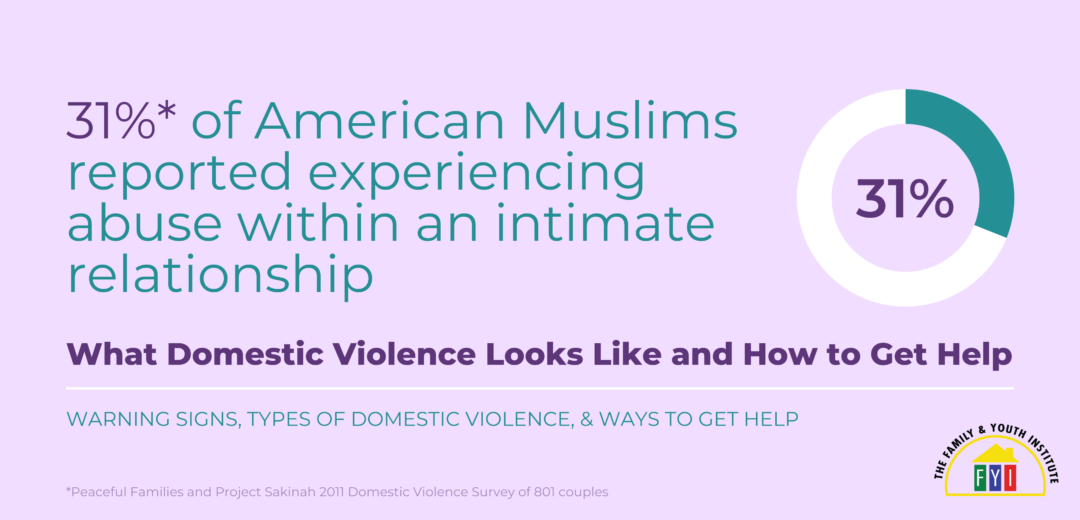Not in Our Community:
What Domestic Violence Looks Like and How to Get Help
This article contains content that may be triggering for victims and survivors of domestic violence.*
Without exception, Islam forbids domestic violence of any kind and towards either spouse. But Ayesha’s story is more common in our Muslim communities than many of us want to accept. According to Peaceful Families and Project Sakinah 2011 Domestic Violence Survey:
-
• 31% of American Muslims reported experiencing abuse within an intimate relationship.
-
• 53% of American Muslims experience some form of domestic violence which may include emotional, verbal, financial, physical or sexual abuse.

What Does Abuse Look Like?
- • Emotional Abuse (82%*) is one of the hardest forms of abuse to recognize. It refers to words and actions used to harm the self-esteem of another person. Its effects can be just as psychologically destructive as physical abuse. Examples: gaslighting, manipulation, isolation, racism, silent treatment, shaming, and insulting.
- • Physical Abuse (74%) is the most observable kind of abuse. It’s used to further assert control and invoke fear in another person. Examples: slapping, throwing down, twisting arms, beating, etc.
- • Financial Abuse (65%), where the abuser has power over finances and restricts the victim’s access to it. He/she may also incur debt in the victim’s name or misuse religious/cultural reasons to maintain control over the finances. Examples: embarrassing the victim when they ask for money, preventing them from having a job, etc.
- • Spiritual Abuse (49%) is when the abuser uses spiritual and religious belief to control the victim. Examples: Misusing religious texts to gain dominance or shame and humiliate victim;“You’re being a bad Muslim and wife/husband” or “Remember the hadith, Angels will curse you all night…”
- • Sexual Abuse (30%) includes any sexual behavior performed without the partner’s consent–even in a marital relationship! Examples: misusing religious/cultural reasons to demand sex, engaging in sexual activity when the victim is not fully conscious or is afraid to say no, etc.
- * These percentages reflect how much abuse was experienced by nearly 2000 Muslim women survivors of domestic violence (in a survey of 9 domestic violence organizations around the U.S; Alkhateeb, 2010).
What Makes it Difficult to Leave an Abusive Relationship?
-
-
• Fear: The victim may be afraid of the consequences of leaving. The dangers of leaving may evoke a greater fear than remaining with the abuser.
-
-
- • Love and Hope: The victim may still feel love for someone, even if he/she is abusive. Abusers also cycle between being abusive to being apologetic and trying to reconcile. When the abuser apologizes and asserts their love for the victim, he/she becomes hopeful that the abuser will change one day.
-
- • Survival: The victim may not be financially independent, relying on the abuser for money and resources. Ending the relationship could leave the victim without a way to meet their basic needs.
-
- • Lack of support system: The victim may not have close family, relatives, or friends that they can reach out to for help. Especially in Muslim circles, many communities will shun the victim once they leave their abuser.
-
- • Low self-esteem: Domestic violence impacts the victim’s self-esteem, leaving them feeling helpless and disempowered, often blaming themselves for the abuse.
-
- • For children: Many victims think keeping the family together is better than leaving and do not always have the emotional resources to see the impact of the abuse on their children.
-
• Normalizing the Abuse: Many victims may have come to learn that verbal and physical abuse is normal in a relationship, especially if they witnessed it growing up. Sometimes, they may believe that the abuse is a test from God and don’t leave out of fear of displeasing God or wanting to “be patient.”
Finding a Way Out of the Cycle of Abuse
- • Tell someone you trust about the abuse. Choose someone who you know will listen and will be there if the situation escalates.
- • Document the abuse. This will help you understand the severity of the situation and help you to make a confident choice about the relationship.
- • Prepare your path to safety. Create a safety plan about when and how to leave, and practice escaping quickly and safely.
- • Get help! If you fear for your safety or are in immediate danger, call 911 or National Domestic Violence Hotline at 800-799-7233. For Deaf & Hard of Hearing: 800-787-3224. You can also chat or text with this service for quick and safe support.
Recognize The Healing You Will Need To Do
Healing from an abusive relationship is a journey, and it will take time.
- • Heal from gaslighting and learn how to trust yourself again.
- • Try these 5 self-care tips such as positive affirmations and channeling the pain into creativity.
- • Find your community. When you leave, so may the people around you who are not ready to support you. Find 2-3 people who can be there for you as you choose to move forward.
- • Speak to a professional counselor. Check out PFP’s directory of Muslim providers who specialize in domestic violence.
- • Check out PFP’s Domestic Violence Toolkit for much more guidance and resources, including information about what you are experiencing and hotlines/organizations you can reach out to for help.
Domestic violence can have a traumatic impact on the physical and psychological well-being of the victim, children, and even extended family. Getting support is the first step toward healing and growing through the abuse. If you or a loved one is experiencing domestic violence, use the resources referenced in this blog and know that help is available. May Allah grant you the courage and strength you need to find safety, comfort, and support.
“Not in our community”: What Domestic Violence Looks Like and How to Get Help
